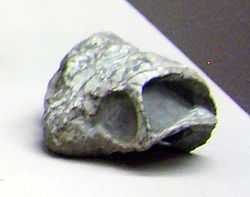Cistecephalus
| Cistecephalus Temporal range: Wuchiapingian, 260.4–253.8Ma | |
|---|---|
 | |
| Cistecephalus angusticeps skull at the Museum für Naturkunde, Berlin | |
| Scientific classification | |
| Kingdom: | Animalia |
| Phylum: | Chordata |
| Clade: | Synapsida |
| Order: | Therapsida |
| Infraorder: | †Dicynodontia |
| Family: | †Cistecephalidae |
| Genus: | †Cistecephalus Owen, 1876 |
| Type species | |
| †C. microrhinus Owen, 1876 | |
Cistecephalus is an extinct genus of dicynodont therapsid from the Late Permian of South Africa. It was a small, specialised, burrowing dicynodont, possibly with habits similar to a modern mole. The head was flattened and wedge-shaped, the body long, and the forelimbs very strong, with similarities in structure to the forelimb of modern burrowing mammals.[1]

It was one of the first genera of dicynodonts to be described, by Richard Owen, in 1876.
Cistecephalus is so far known from the Cistecephalus Assemblage Zone of the South African Karoo, as well as from Zambia and India. A very similar genus, Kawingasaurus, is known from the Kawinga Formation of Tanzania, which is probably equivalent in age to the Cistecephalus zone.
Cistecephalus could reach up to 60 centimetres (24 in) in length.
References
- King, Gillian M., 1990, the Dicynodonts: A Study in Palaeobiology, Chapman and Hall, London and New York
- Nasterlack, Tobias, Canoville, Aurore, and Chinsamy Anusuya, 2012. New Insights Into The Biology Of The Permian Genus Cistecephalus (Therapsida, Dicynodontia), Journal of Vertebrate Paleontology 32:6, 1396-1410.
External links
| ||||||||||||||||||||||||||||||||||||||||||||||||||||||||||||||||||||||||||||||||||||||||||||||||||||||||||||||||||||||||||||||||||||||||||||||||||||||||||||||||||||||||||||||||||||||||||||||||||